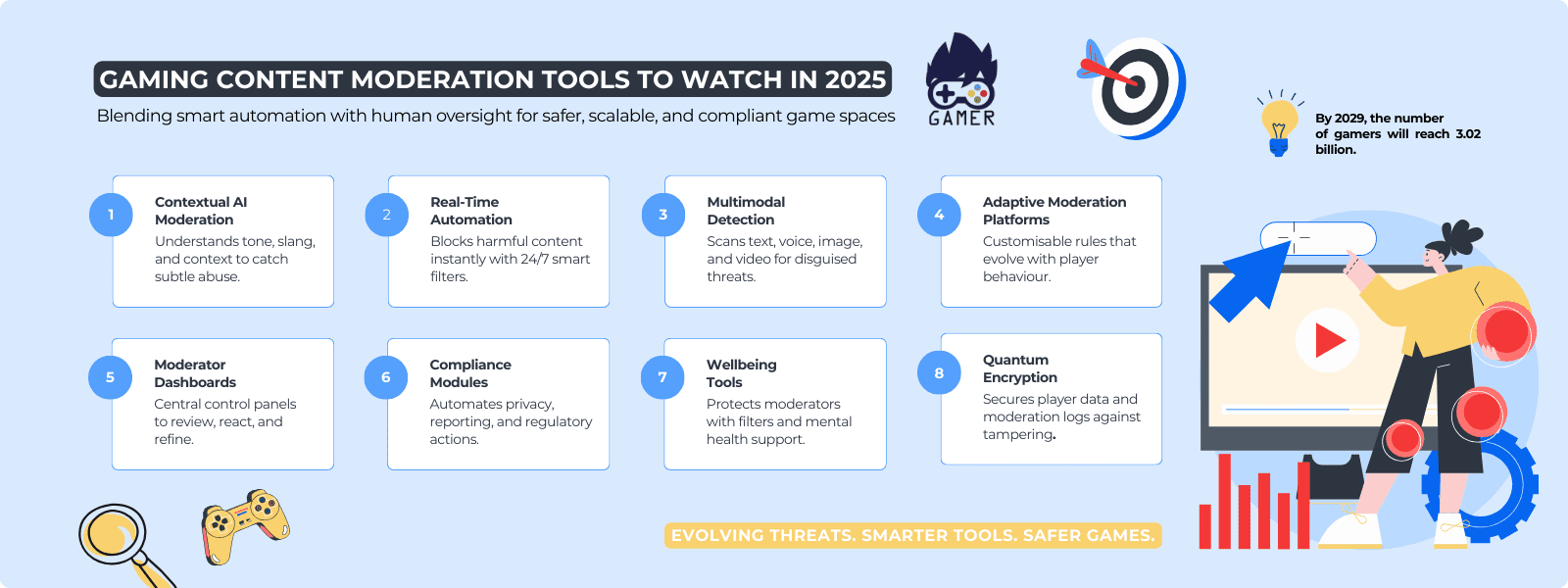Introduction
With billions of players worldwide and numbers continuing to rise, maintaining security and compliance in gaming communities is becoming increasingly complex. This demands strong, flexible Trust and Safety solutions that can process large volumes of data quickly and accurately. Modern content moderation tools play a vital role, enhancing human oversight and strengthening the protective shield around user well-being and privacy at scale. Ultimately, they begin a new era in online gaming integrity and accountability.
Entertainment studios now face the challenge of managing countless real-time interactions across multiple languages and cultures, where traditional manual oversight or basic automated filters are no longer sufficient. One of the biggest hurdles is proactively detecting and removing inappropriate text, voice, or imagery before reaching the user base.

In response to the urgent demand for improvement, new systems are emerging, evolving, and multiplying. From automated language filters and behaviour pattern detection to advanced dashboards for personal oversight, all the software is essential to scaling in-game moderation operations without compromising quality.
Powered by machine learning and real-time analytics, it helps identify violations early, limit harm, enforce community guidelines quickly, reduce response times, and enable well-informed decisions.
Welcome to the New Era of Intelligent Gaming Moderation
Whether driven by necessity or strategic foresight, the new balance of power redefines virtual security and operational efficiency. It embodies a symbiosis between human effort and technology, setting new standards for usability, player online safety, and scalability that are now cornerstones of the future of gaming.
This reflects a broader shift towards intelligent, multi-layered defences designed to safeguard the platform and the integrity of the user experience. The result is a safer, more consistent environment that fosters trust without overwhelming moderation teams or demanding unsustainable headcount growth.
Building a resilient, tech-enabled moderation framework is no longer optional. It is foundational in a landscape where reputational damage spreads rapidly and regulatory scrutiny intensifies.
The Case for Enhanced Gaming Security: Threats You Cannot Simply Ignore
Gaming has evolved into a vast, interconnected universe, offering developers, studios, and players extraordinary opportunities. However, with this scale and diversity comes a new set of risks. What began as a casual pastime is a high-stakes, global arena where millions interact daily, often across borders, cultures, and age groups. As platforms expand, so do the complexities of safeguarding players and communities.
Below are the key drivers shaping the urgent need for enhanced protection:
Toxic behaviour in online games
Today’s gaming is a global, cross-generational, and deeply public sphere that mirrors the full spectrum of society, including its darker aspects. Behind the energy and connectivity lies a troubling reality: abuse, harassment, hate speech, and discrimination.
Without the relevant safeguards, platforms risk becoming breeding grounds for toxicity, manipulation, cyberbullying, and even more severe threats such as online grooming, scams, and exposure to sexual or violent content, particularly for younger players.
Moreover, generative AI and synthetic content, such as deepfakes, add further complexity, prompting businesses to build even more robust, adaptive moderation frameworks.
When Capacity Pressure Snowballs
Another challenge lies in the sheer scale and complexity of user participation. From children to grandparents, across Asia, Europe, and the Americas, gaming connects billions who play, compete, and socialise daily. Each new player adds diversity, behavioural nuance, and unpredictability to the ecosystem.
As a result, studios face mounting pressure to monitor millions of interactions, detect misconduct early, and enforce policies fairly. Simultaneously, the well-being of moderation teams must be safeguarded, as constant exposure to harmful content can take a serious psychological toll.
Achieving both effectiveness and care is critical, yet far from simple. A well-defined, resilient strategy is essential.
Legal and Regulatory Pressure
Regulators worldwide are tightening their grip on unmoderated digital spaces, and gaming platforms are now firmly in the spotlight. New laws have set enforceable standards for transparency, user rights, and platform accountability.
Therefore, companies must provide clear moderation policies, enable users to challenge decisions, and implement fast, structured reporting systems.
All terms and processes must be easily understood and aligned with current legal requirements. Failing to comply invites financial penalties and threatens platform access and long-term credibility.
Below are some key statistics illustrating the scale and urgency of the challenges. They highlight the critical need for safe, inclusive spaces where players feel secure, welcome, and able to enjoy their time online.
Over a third of gamers (38.2%) say they have been directly targeted by hate-based harassment, most often because of their ethnicity (24.4%), gender (19.9%), or sexual orientation (10.6%) (Source: Frontiers).
The number of global gamers is expected to grow by 0.4 billion (15.5%) from 2024 to 2029. After seven years of growth, the total will reach a new high of 3.02 billion users in 2029 (Source: Statista).
In the UK, the national communications regulator, Ofcom, can now fine companies up to £18 million or 10% of their annual global revenue if they fail to meet online safety standards (Source: Lewis Silkin).
Gaming security tools to watch in 2025
The intricate gaming digital safety demands customisable solutions that increasingly yet thoughtfully blend automation with human expertise. Overall, the best tools for moderating gaming communities must scale rapidly, adapt to diverse player behavioural patterns, and comply with global regulations. While many such enablers aim to meet the demands, a select few stand out for their ability to deliver power and nuance.

1. AI-Powered Contextual Moderation Engines
First, these innovative tools use artificial intelligence and machine learning to go beyond simple keyword spotting. They analyse in-game chats, voice interactions, images, and video streams, interpreting the subtle layers of context, intent, tone, and the ever-shifting slang players use. This enables them to catch complex issues like coded hate speech, sarcasm, grooming behaviour, and manipulated media. With support for multiple languages and AI models tailored to specific needs, platforms can fine-tune content moderation to fit their unique community cultures and risk landscapes.
2. Real-Time Automated Moderation Systems
Then, automation software from the frontline defence instantly scans and filters harmful content such as spam, scams, child sexual abuse material (CSAM), and verbal abuse. Using sentiment analysis, rule-based filters, and scalable AI, these systems operate around the clock and flexibly scale to match player volume. This immediacy is vital in the fast-moving world of multiplayer games, stopping damaging activities before they can take hold.
3. Multimodal Content Analysis Tools
Furthermore, effective moderation today also means simultaneously handling all kinds of content, such as text, voice, images, video, and live streams. Image matching technology, voice recognition, and computer vision can uncover explicit or illegal material, even when disguised to slip past filters. This broad, multimodal approach ensures no inappropriate materials hide in the shadows, particularly in gaming areas rich with user-generated media.
4. Customisable and Adaptive Moderation Platforms
In addition, no two gaming communities are alike. Agile moderation platforms provide the flexibility to set specific behavioural rules, response protocols, and tolerance thresholds that reflect a game’s unique culture and policies. By integrating adaptive AI models, these systems continuously learn from new trends, shifts in community behaviour, and edge cases, ensuring that moderation evolves alongside the player base and gameplay dynamics.
5. Moderator Dashboards and Analytics Suites
Moreover, centralised dashboards bring all oversight activities into one straightforward interface. They help teams efficiently review flagged content, manage interventions, and draw insights from moderation data. These suites foster transparency and allow people to track performance, audit decisions, and quickly react to new threats or trends.
6. Compliance and Transparency Modules
These modules are also essential in light of stricter global regulations. They automatically keep records, create clear reports, speed up content removal, and include built-in privacy features like age checks and hiding personal data. These features help gaming platforms meet legal obligations, handle user appeals effectively, and build community trust.
7. Moderator Wellbeing and Support Tools
Ultimately, recognising the heavy psychological toll of exposure to distressing content, modern solutions now include features to safeguard moderator health. Screening controls, tailored filters, access to mental health resources, and workload management tools play a role. Supporting moderators’ well-being reduces burnout and ensures sound judgment and consistent service quality.
8. Quantum Encryption Solutions
Quantum encryption is rapidly becoming essential for gaming security, using advanced cryptography to keep player data and moderation records, like chat logs and flagged content, completely confidential and tamper-proof. By protecting sensitive information from interception or manipulation, this technology helps gaming platforms meet strict global data privacy regulations. It builds player trust by demonstrating a strong commitment to privacy and the integrity of moderation decisions.
Critical Areas for Modern Moderation in Gaming
As gaming platforms grow increasingly interconnected and diverse, several key areas have emerged as critical for effective content moderation. As a result, the segment’s dynamic, social nature demands advanced tools to mitigate specific risks and challenges precisely. Below are gaming scenarios that require targeted moderation approaches to maintain safety, fairness, and community trust.
Instant Oversight in Competitive Arenas
First, multiplayer games, especially those featuring ranked ladders, team-based objectives, or open matchmaking, are hotspots for toxic behaviour, harassment, and cheating. The competitive intensity often fuels offensive language, griefing, and even coordinated abuse.
In these environments, real-time AI-powered chat and voice moderation tools are indispensable. They can instantly flag hate speech, threats, or suspicious behaviour, automatically mute or warn offenders, and escalate severe cases to human moderators.
Meanwhile, automated anti-cheat systems monitor gameplay patterns to detect exploits or hacks, preserving fairness and trust within the competitive ecosystem.
Safeguarding Creative Spaces
Furthermore, games that enable players to create, share, or trade content, so-called social hubs, such as custom maps, avatars, or in-game assets, also face unique moderation challenges.
Vigilant oversight is necessary to prevent the spread of inappropriate, illegal, or copyrighted material. AI-driven image and text analysis tools rapidly scan uploads for explicit content, hate symbols, or plagiarism.
These automated filters, combined with human review for complex or borderline cases, help sustain a safe, creative environment while respecting players’ freedom of expression.
Live Moments Moderation
Lastly, live tournaments, virtual concerts, and in-game streaming introduce fresh oversight complexities.
Harmful behaviour or disruptive incidents can instantly reach thousands of viewers, making swift action essential. Instant screening tools with automated detection for offensive language, disruptive audio, or inappropriate visuals are crucial.
Human moderators remain on hand to intervene immediately during live broadcasts, freezing or muting streams to prevent escalation and protect the audience experience.
A New Role of Human Moderators in Gaming
While content moderation tools are deployed to handle the speed and scale of in-game interactions, humans’ roles are evolving beyond enforcement. Most importantly, moderators are increasingly seen as gatekeepers, community stewards, cultural interpreters, and escalation specialists in modern gaming ecosystems.
The Human Touch: Empathy and Judgment in Complex Interactions
Proactive Guardians: Shaping Systems and Community Standards
Visible Stewards: Building Trust Through Fair, Consistent Screening
People provide vital context and emotional intelligence in fast-paced spaces that AI cannot replicate. They review edge cases, make judgment calls based on community norms, and engage directly with players in moments that require empathy or clarification. This personal element is particularly important in games with live chat, role-playing elements, or complex social dynamics.
Moderators are also playing a more proactive role, identifying emerging trends, flagging gaps in automated systems, and contributing to the refinement of platform policies. Some serve as bridges between developers and communities, offering insights into player sentiment, escalating critical issues, and helping shape safer, more inclusive game environments.
As moderation becomes more transparent, moderators are expected to embody fairness and consistency, often acting as the public face of enforcement. In community-driven titles or live-service games, their presence can build trust, promote positive behaviour, and reinforce a sense of shared values.
Moderating Online Communities: Best Practices
Effective deployment of content moderation tools in gaming requires more than technology. It demands a thoughtful, community-aware strategy. Below are the essential best practices for ensuring moderation enhances player safety without compromising user experience.
1. Balance Automation with Human Insight: Use AI to manage high volumes of content and detect real-time risks, but rely on moderators for nuanced decisions, cultural sensitivity, and empathy. Equip them with innovative tools, rotation systems, and mental health support to ensure long-term effectiveness.
2. Continuously Improve Data and Models: The gaming language evolves fast, so must your models. Regularly annotate edge cases and retrain systems using high-quality, game-specific data to reduce bias, prevent false positives, and keep moderation context-aware.
3. Moderate Behaviour, Not Just Words: Shift from reactive keyword filters to behavioural tracking. Spot patterns of harassment, griefing, or manipulation across sessions, not just isolated messages, for deeper, more proactive risk detection.
4. Tailor Moderation to Your Game and Community: Customise tools to reflect your game’s tone, age rating, gameplay, and cultural context. Build flexible systems that accommodate regional norms and evolving community expectations while aligning with your brand.
5. Prioritise Prevention and Player Input: Deploy smart filters, nudges, and automated pre-moderation to stop harm before it spreads. Meanwhile, create robust player feedback loops for flagging content, appealing decisions, and shaping moderation fairness.
6. Use Transparency and Insights Strategically: Finally, maintain clear, auditable moderation workflows to build trust and meet compliance needs. Analyse moderation data to uncover trends, emerging threats, and feature gaps, turning safety into a strategic asset.
Conclusion
In summary, strengthened protection is the future of gaming. As communities grow and the boundary between entertainment and identity fades, content moderation must evolve from a reactive shield into a strategic design principle. This shift will define the next generation of platforms.
The real benchmark will not be how effectively companies prevent abuse, but how confidently they empower players to feel safe, express themselves, and play without compromise. Studios must learn how to use content moderation tools in online games. Whether they build proprietary infrastructure or partner with a specialised BPO provider, the objective remains singular.
The goal is to create gaming environments where safety is not a barrier, but a catalyst for engagement, growth, and long-term loyalty.






















